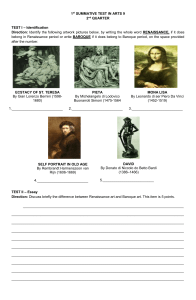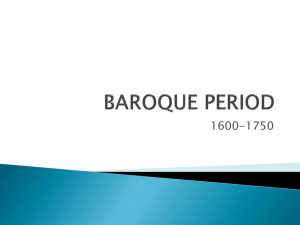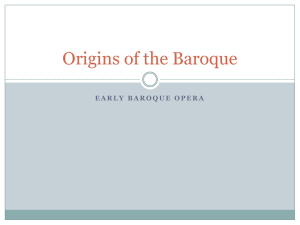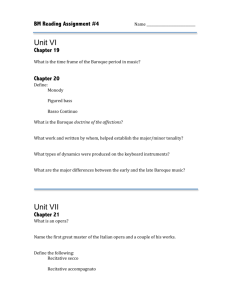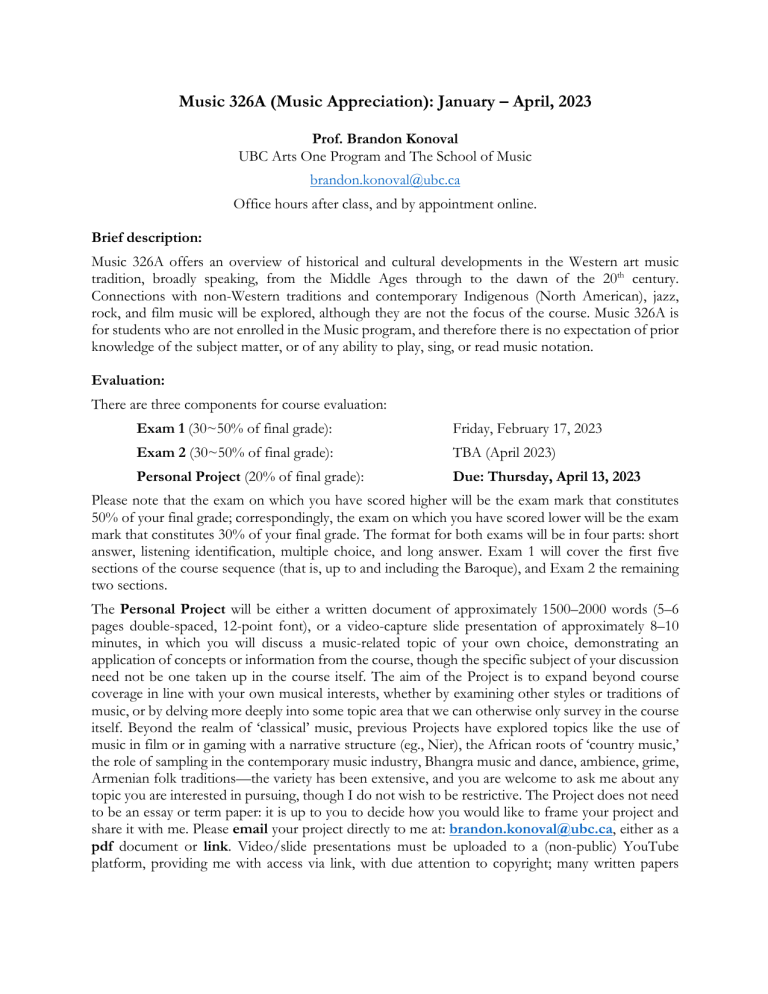
Music 326A (Music Appreciation): January – April, 2023 Prof. Brandon Konoval UBC Arts One Program and The School of Music brandon.konoval@ubc.ca Office hours after class, and by appointment online. Brief description: Music 326A offers an overview of historical and cultural developments in the Western art music tradition, broadly speaking, from the Middle Ages through to the dawn of the 20th century. Connections with non-Western traditions and contemporary Indigenous (North American), jazz, rock, and film music will be explored, although they are not the focus of the course. Music 326A is for students who are not enrolled in the Music program, and therefore there is no expectation of prior knowledge of the subject matter, or of any ability to play, sing, or read music notation. Evaluation: There are three components for course evaluation: Exam 1 (30~50% of final grade): Friday, February 17, 2023 Exam 2 (30~50% of final grade): TBA (April 2023) Personal Project (20% of final grade): Due: Thursday, April 13, 2023 Please note that the exam on which you have scored higher will be the exam mark that constitutes 50% of your final grade; correspondingly, the exam on which you have scored lower will be the exam mark that constitutes 30% of your final grade. The format for both exams will be in four parts: short answer, listening identification, multiple choice, and long answer. Exam 1 will cover the first five sections of the course sequence (that is, up to and including the Baroque), and Exam 2 the remaining two sections. The Personal Project will be either a written document of approximately 1500–2000 words (5–6 pages double-spaced, 12-point font), or a video-capture slide presentation of approximately 8–10 minutes, in which you will discuss a music-related topic of your own choice, demonstrating an application of concepts or information from the course, though the specific subject of your discussion need not be one taken up in the course itself. The aim of the Project is to expand beyond course coverage in line with your own musical interests, whether by examining other styles or traditions of music, or by delving more deeply into some topic area that we can otherwise only survey in the course itself. Beyond the realm of ‘classical’ music, previous Projects have explored topics like the use of music in film or in gaming with a narrative structure (eg., Nier), the African roots of ‘country music,’ the role of sampling in the contemporary music industry, Bhangra music and dance, ambience, grime, Armenian folk traditions—the variety has been extensive, and you are welcome to ask me about any topic you are interested in pursuing, though I do not wish to be restrictive. The Project does not need to be an essay or term paper: it is up to you to decide how you would like to frame your project and share it with me. Please email your project directly to me at: brandon.konoval@ubc.ca, either as a pdf document or link. Video/slide presentations must be uploaded to a (non-public) YouTube platform, providing me with access via link, with due attention to copyright; many written papers provide links to online video just as I provide links to music examples in our textbook and repertoire lists. Course Materials: There is no published textbook that you are required to purchase for Music 326A: I have written a textbook for our own use, along with repertoire sheets containing links to open access videos (all found on YouTube). All course materials are therefore specific to our needs, and provided at no extra cost. I will release each chapter of the textbook as a pdf document at the start of each section of the course, as identified by the course outline provided below. Please note: the textbook chapters provided as pdf documents are comprehensive; thus, if you miss a class or two, you will be able to readily recover all the information you have missed, though without the guided listening experiences provided in the classroom. (Many of the chapters nonetheless have multiple listening charts, to help all students revisit and review what has been listened to in class.) However, you are expected to attend lectures regularly and to take your own notes: if you fail to do so, you may find it difficult to distinguish contextual information in the course notes from the core concepts and examples that you will be examined upon. Exams are based upon what is taught in the live classroom setting, and the textbook is a support that you can use to situate and review what you have learned in the classroom. MUSC326A: Course Outline 1. Prelude: What’s My Role in Music Appreciation? Appreciation and Participation Building Musical Dimensions: Melody and Accompaniment Pachelbel’s Canon Imitation and Melody Going for Baroque 2. Texture in Music Relative Behavior and Relative Prominence Monophony Pitch and Pitch-class Ambiguity in Musical Texture Texture in Transition: From Monophony toward Polyphony Polyphony Imitative Polyphony Homophony Alternating and Superimposing Textures Musical Texture: Basic Features to Listen For 3. Medieval Music: An Introduction Why Start Here? And Other Key Questions in Medieval Music What are we actually listening to? Music and Historical Imagination Preservation through Notation: The ‘Gregorian’ Project Tradition and Innovation I: From Chant to Organum and Motet Melody and Mode Tradition and Innovation II: From Chant to Mass and Hymn 4. Renaissance Music: An Introduction The Origins of a Renaissance A Rebirth of What? Secular Music in the Renaissance I: Songs Secular Music in the Renaissance II: Instrumental Dances, Rhythm, and Meter Humanism: Renaissance Time Travel, Secular and Sacred Text Sources, Translations, and Religious Practices The Mass: Before and After Luther The Hymn 5. Music of the Baroque Era Is there a ‘Baroque Style’? The Tragedy of Dido and Aeneas A Counterpoint of Styles Opera Seria, or The Rebirth of Tragedy Components of Opera Seria I: Aria and Recitative Components of Opera Seria II: The Chorus Components of Opera Seria III: Instrumental Numbers and the Libretto Sacred Vocal Music and Protestant Tradition The Cantata, Sacred and Secular The Baroque Mass The Baroque Oratorio Changing Roles for the Composer and Performer The Baroque Concerto Ritornello Structure and the Concerto Grosso Preludes and Fugues Midterm Exam (units 1 through 5) 6. Music of the Classical Era What does ‘Classical’ Mean? Opera Buffa, or The Birth of (Musical) Comedy The Cosmopolitan Composer Opera and Musical Entrepreneurship The Magic Flute: Cultural, Philosophical and Political Contexts The Magic Flute: Components of a Cosmopolitan Opera The New Orchestra and New Instrumental Genres Components of the Classical Symphony and Orchestra The Symphony and Sturm und Drang Hybrid Forms: Sonata meets Rondo The Classical Concerto and Sonata Form Revolution from Within: Beethoven’s “Moonlight” Sonata 7. Music of the (long) 19th Century A ‘Romantic Era’ of Music? Revolution from Without: Beethoven’s Ninth Symphony Berlioz and Programmatic Music Programmatic Music, Self-Expression, and Organicism Tchaikowsky and the Concert Overture Wagner and the ‘Total Work of Art’ Schubert and the Lied Chopin, Schumann, and the Piano Character Piece New Directions and the Response to Romanticism: Debussy, Stravinsky, and Schoenberg
